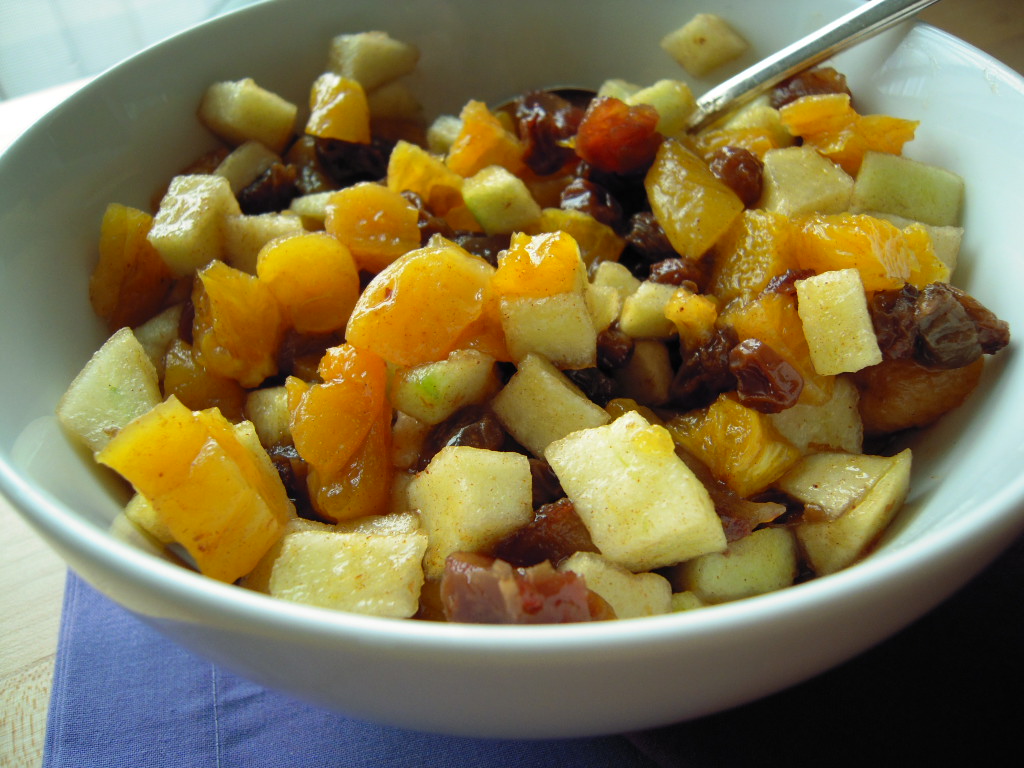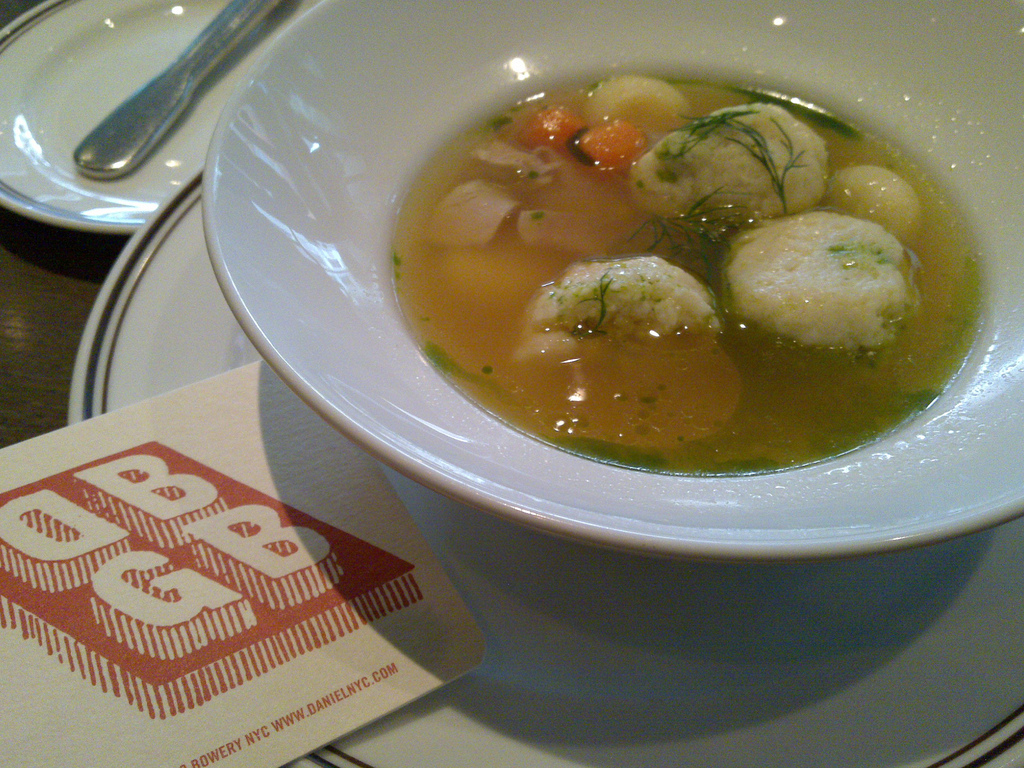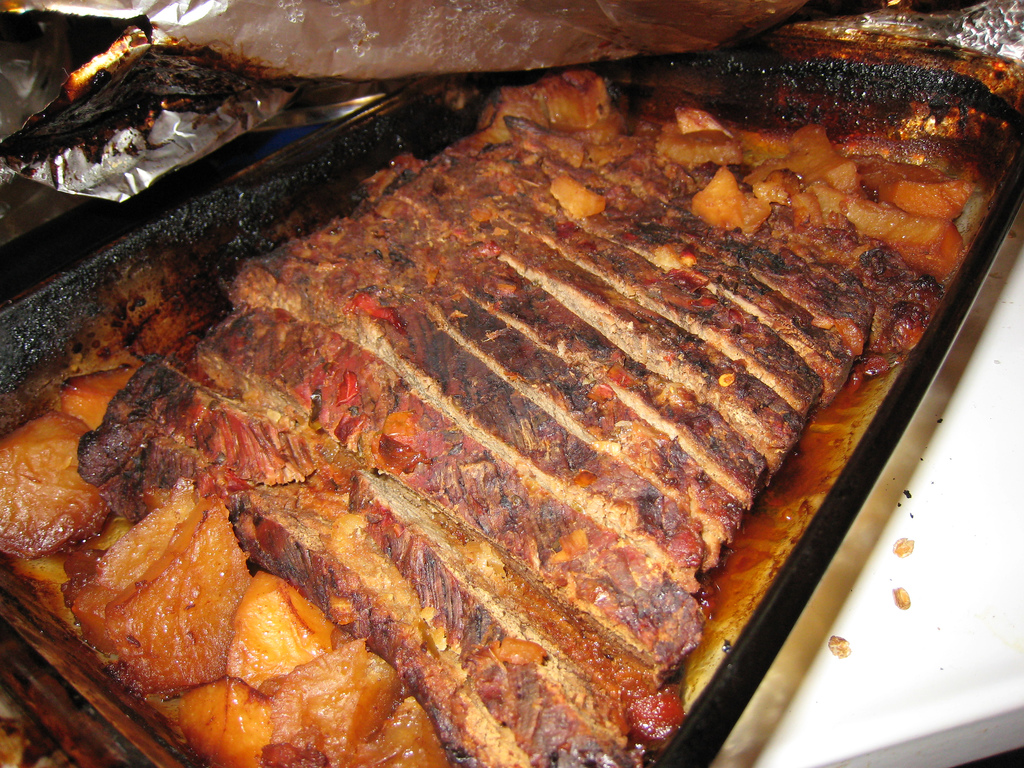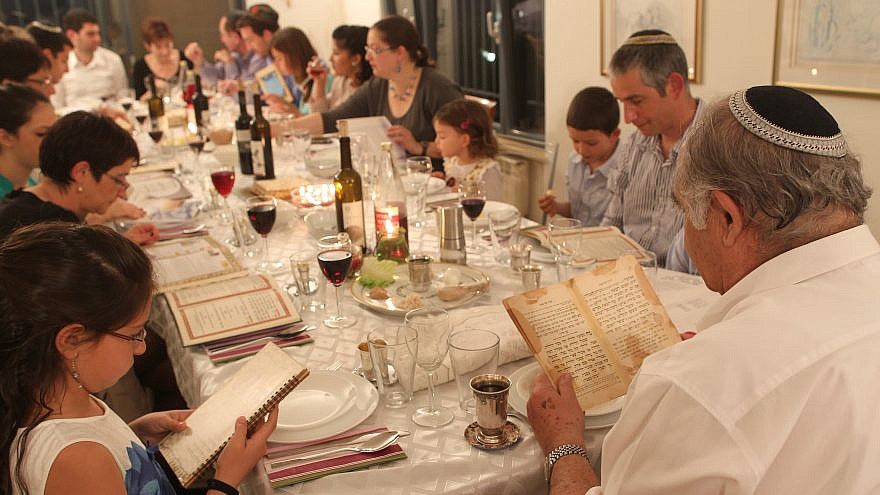Sweet gefilte fish with a dollop of eye-watering horseradish. Fluffy matzah balls floating in golden chicken soup, raisin-dotted matzah kugel, tangy stuffed cabbage, crunchy charoset, mile-high sponge cake.
This time of year (Passover—or Pesach in Hebrew—begins at sundown Friday, April 19, also the start of Shabbat), you may come upon recipes faded by the years in the handwriting of beloved mothers or grandmothers tucked into old cookbooks or recorded on yellowed index cards.
But when the nostalgia lifts, if you’re not careful, eight days (make that seven in Israel) of these wonderful time-honored Passover foods can also widen your waistline, dull your brain in a perpetual carb-fog and slow your kishkas to a near standstill.
Fortunately, there’s an art to preparing traditional foods that retain the power to pass on to the next generation this beloved family holiday while eating smart, creating a Passover that’s healthful without losing its soul.
Joan Nathan, the Julia Child of Jewish cooking, has updated many of her family’s Passover dishes, including Passover recipes, for her latest, King Solomon’s Table: A Culinary Exploration of Jewish Cooking from Around the World (Knopf).
“Seder night is a big deal in our family,” says Nathan, who each year hosts as many as 40 guests for the big event and, the week prior, holds a “gefilte-in” for friends to come and cook together.
Beginning with the salad, Nathan adds the key ingredient of creativity to every course, with a special focus on using vegetables to keep the “HQ” (health quotient) high. And she loads her mother’s traditional brisket recipe with plenty of carrots.
Paula Shoyer, author of The Healthy Jewish Kitchen (Sterling Epicure, 2017) and The New Passover Menu (Sterling Epicure), suggests an easy formula for “lightening up” traditional recipes: Take down the sugar a notch; replace some matzah meal with other kosher-for-Passover options like a mixture of almond and coconut flour; and use coconut oil (look for extra-virgin with a reliable hechshers, kosher symbols) instead of the ever-present margarine.
“And people will find that if they cook from scratch, they’ll avoid all the unhealthy chemicals in the packaged Passover foods—and save money, too,” notes Shoyer. “It only takes a few more minutes to make brownies yourself.” Creating a salad dressings of olive oil and vinegar with spices can help you dodge some of the arguably less healthful oils (peanut and cottonseed among them) long associated with Passover cooking.
Israelis are mad about cauliflower and zucchini, and both of these are spotlighted in Steven Rothfeld’s love letter to Israeli cuisine Israel Eats(Gibbs Smith). Note: On Passover Israelis are split between Sephardic tradition, which allows the eating of kitnyot (most notably legumes and rice), and Ashkenazi custom, which considers these things to be chametz—not kosher for Passover. (Though in the spirit of what Rothfeld calls “Israeli fusion,” in recent years many Ashkenazim in Israel and elsewhere have opted to spend Passover eating like Sephardim). Tip to shoppers: You’ll notice that many “Kosher for Passover” products add the word “Kitniyot” somewhere on the package as a warning to consumers whose tradition is to avoid it. (Not sure what’s kitniyot? Arlene Mathes-Scharf of kashrut.com put together this list with the late Rabbi Zuche Blech: https://askcrc.org/item/Passover/186968)
“The best advice I can give for keeping healthy on Passover is to listen to your body,” adds Rothfeld. “Just because it’s a holiday, don’t overeat, and even though it looks amazing, don’t eat it if you’re not hungry.” (Kind of the flip side to the Haggadah notation: “All who are hungry, come and eat.”)
Then there the folks whose food sensitivities—to gluten, nuts or dairy for instance—make Passover a dietary challenge. When Marcy Goldman’s nut-allergic son longed to eat her charoset, a delicious part of the seder that calls for nuts, she quickly went to work concocting a version he could safely enjoy. The result? “Paradise Charoset” in her Newish Jewish Cookbook (River Heart Press).
Goldman also makes a point of slipping healthful, colorful veggies and fruits into other traditional dishes, creating such treats as her “Three-Level Kugel.”
“You can eat smart over Passover,” she insists. “You don’t have to recycle potatoes, kugels and roast all week. And remember, it only takes one or two Passovers to make your adaptations into your family Passover traditions.”
There is also oat matzah on the market that solve the gluten-free problem (you may need to order them if they’re not available near you), as they’re kosher for making a bracha (“blessing”) over (Note: Not all gluten-free matzah are, just the oat). And those sensitive to nightshades such as white potatoes will have to be vigilant about scouring the labels due to the literally tons of potato starch used in prepared kosher-for-Passover foods.
As for the most common health complaint from Passover—the infamous constipating powers of matzah and its by-products—Nathan says her ancestors were wise enough to build relief right into their traditional holiday recipes. “Our family always serves our krimsel (matzah fritters) with plenty of stewed prunes … even way back then, they understood.”
Tips for Getting Through Passover Healthfully:
Drink L’Chaim to Life. Upping the hydration gives your digestion a fighting chance of moving that slow-mo’ matzah train down the tract.
Don’t Be a Coach Potato. Staying active, and taking a brisk walk daily either before meals or after the dishes are done, can also help keep you functioning physically and mentally as well as spiritually.
Four Cups to the Wind. Even though the minimum for each of the four cups is about 3 ounces, all that alcohol on an empty stomach can make you feel sick, if not downright tipsy. Let your body signal you when to cut back. Or there’s always grape juice for those who cannot drink wine for medical or other reasons.

Marcy Goldman’s Nut-Free Passover Paradise Charoset (Pareve)
Ingredients:
2 cups fresh cranberries
½ cup dried cherries
¼ cup dried cranberries
⅓ cup yellow raisins
2 cups coarsely chopped apples
½ cup sugar
¾ cup water
½ cup water or orange juice
2 tablespoons sweet red wine
½ teaspoon cinnamon
Directions:
Place all ingredients in a medium saucepan.
Over low-medium heat, cook the fruit slowly until the apples soften and the cranberries pop open. Stir, ensuring mixture does not burn on bottom. You may have to lower the heat.
After mixture is cooked down and is thicker, adjust tartness to taste with more orange juice and sugar. If it seems too thick, add a touch more water or orange juice. Cool well. Refrigerate after it cools down.
Serve cold or room temperature. (Some of this is used on the seder plate; a side dish may be offered with the main meal.)
Makes about 1¾ cups.

Best Matzah Balls (with Olive Oil) by Weekend Cook (Pareve)
From Allrecipes.com
Ingredients:
4 eggs
6 tablespoons olive oil
⅓ cup club soda
2 tablespoons club soda
½ teaspoon salt
1½ cups matzah meal, or more as needed
4 quarts water
Directions:
Whisk eggs and olive oil in a bowl until combined.
Stir both amounts of club soda and salt into egg mixture.
Mix matzah meal into wet ingredients to form a workable dough; if mixture is too wet, stir in a ¼ cup more matzah meal. Cover and refrigerate for 30 minutes.
Bring water to a boil in a large pot.
Wet your hands and form matzah-ball dough into walnut-size balls. Gently place matzah balls into boiling water.
Reduce heat to low, cover and simmer matzah balls until tender, 25 to 30 minutes.
Note: For firm/hard-middle matzah balls, either reduce the seltzer or add ¼ cup matzah meal.
Stuffed Cabbage from Oratorio in Zichron Ya’acov, as published in Steven Rothfeld’s Israel Eats (Meat)
Ingredients:
1 medium green cabbage
1 cup jasmine rice, rinsed
5 tablespoons olive oil, divided
1 small onion, minced
21 ounces ground lamb
½ cup chopped mint leaves
2 medium tomatoes, grated
2 tablespoons toasted pine nuts
2 tablespoons chopped dried cranberries
1 teaspoon ras el hanout (a Moroccan spice blend)
Salt and freshly ground pepper
1 generous cup chicken stock or broth
⅓ cup fresh lemon juice
1 large garlic clove, crushed
Directions:
Preheat the oven to 350 degrees.
Freeze the cabbage for 24 hours to facilitate separating of leaves.
Defrost cabbage. Separate leaves, trying not to rip them. The more whole leaves, the better.
Bring a small pot of water to a boil. Add the rice and simmer for 20 minutes. Drain.
Heat 2 tablespoons of the olive oil in a large heavy skillet over medium heat. Add the onion and sauté until softened, about 5 minutes. Add the lamb and sauté until browned and no pink remains, 8 to 10 minutes.
Stir in the blanched rice, mint, tomatoes, pine nuts, cranberries and ras el hanout. Season generously with salt and pepper.
Arrange one-fourth of the cabbage leaves in the bottom of a medium-size Dutch oven or heavy pot. Top with a third of the meat mixture. Cover with another fourth of the cabbage leaves. Top with another third of the meat mixture. Cover with another fourth of the cabbage leaves. Top with the remaining third of the meat mixture. Cover with the remaining fourth of the cabbage leaves.
Pour in the chicken stock and lemon juice. Add the garlic clove; season generously with salt and pepper.
Cover tightly and cook for 1½ hours. Remove the lid from the pot. Cover contents of the pot with a plate, then top the plate with a brick or cans as weight.
Refrigerate overnight. Bring the cabbage cake to room temperature. Cut into slices and serve.
Joan Nathan’s Salmon-Gefilte Fish Mold with Horseradish and Beet Sauce (Pareve)
Makes 15 to 20 slices
Ingredients:
2 pounds salmon fillets
1 pound cod, flounder, rockfish or whitefish
3 medium red onions, peeled and diced (about 2 pounds)
3 tablespoons vegetable or canola oil
4 large eggs
4 tablespoons matzah meal
2 large carrots, peeled and grated
4 tablespoons snipped fresh dill, plus more for garnish
1 tablespoon salt, or to taste
2 teaspoons freshly ground pepper
1 teaspoon Dijon mustard
2 tablespoons sugar parsley, for garnish
Horseradish and beet sauce (see below)
Directions:
Have your fish store grind the fillets or pulse them yourself, one at a time, in a food processor or meat grinder. If using a food processor, pulse the fish in short bursts, being careful not to purée the fish; you want some texture.
Preheat the oven to 325 degrees.
Grease a 12-cup Bundt pan and fill a larger pan (such as a large Pyrex dish) with 2 inches of hot water.
In a large pan over medium-high heat, sauté the diced onions in the oil for about 5 minutes, until soft and transparent but not brown. Set aside to cool.
Put the fish, onions, eggs, 2 cups water, matzah meal, carrots, 4 tablespoons dill, salt, pepper, mustard and sugar in the bowl of a standing mixer equipped with a flat beater. Beat at medium speed for 10 minutes.
Pour the mixture into the Bundt or tube pan, and then put the pan inside the larger water-filled dish (called a bain-marie). Smooth the top with a spatula. Cover with aluminum foil and bake for 1 hour or until the center is solid.
Remove the Bundt or tube pan from the water dish; allow the terrine to cool slightly for at least 20 minutes. Slide a long knife around the outer and inner edges of the Bundt or tube pan, then carefully invert the terrine onto a flat serving plate.
Refrigerate for several hours or overnight. If any water accumulates on the serving dish, carefully drain it away before serving.
Slice the terrine as you would a torte, garnished with parsley and dill and served with Horseradish and Beet Sauce (see recipe below).
Horseradish and Beet Sauce (Pareve)
Makes about 4 cups
Ingredients:
3 large beets (about 2 pounds, trimmed but not peeled
3 tablespoons extra-virgin olive oil
4 ounces (about 1 cup) peeled and roughly chopped fresh horseradish root
2 tablespoons white vinegar
1 teaspoon kosher salt
1 teaspoon black pepper
1 to 2 tablespoons fresh lemon juice
Directions:
Heat the oven to 350 degrees.
Rub the whole beets with 1 tablespoon of olive oil and wrap in foil. Bake the beets for about an hour or until tender in the center when pierced with a knife. Remove from the oven and allow to cool, and then peel and cut into large chunks.
In the bowl of a food processor, mix the horseradish and the vinegar. Process with the steel blade until finely chopped; do not purée. Add the beets and remaining olive oil. Pulse until the beets are coarsely chopped, but not puréed. Transfer to a bowl and add the salt, pepper, and lemon juice to taste.
Adjust the seasoning as needed. Cover and refrigerate for at least a day.
Serve as an accompaniment to the Salmon-Gefilte Fish Mold (see recipe above).

Joan Nathan’s Favorite Brisket (Meat)
Ingredients:
2 cups dry red wine
2 stalks celery with leaves, chopped
1 bay leaf
1 sprig fresh thyme
1 sprig fresh rosemary
8 carrots, peeled and cut into ½-inch diagonal slices
¼ cup chopped fresh parsley
Directions:
Preheat oven to 325 degrees.
Place onions and garlic in a 5-quart to 6-quart casserole. Season brisket with salt and pepper.
In a large skillet, heat oil over high heat and sear brisket until browned, 3-4 minutes on each side.
Place fat-side-up on top of onions. Add tomatoes and their juice, breaking them up with a fork.
Add the wine, celery, bay leaf, thyme and rosemary.
Cover casserole and bake for 3 hours, basting with pan juices every half-hour.
Marcy Goldman’s Three-Level Kugel (Pareve)
Makes 8-10 servings
Broccoli Layer:
1 pound broccoli, cooked, chopped fine
3 eggs
½ cup matzah meal
1½ teaspoon garlic powder
¾ teaspoon salt
3/8 teaspoon pepper
Carrot-Squash Layer:
2 cups carrots, shredded
1 cup butternut squash, cooked and mashed
¼ cup brown sugar
1 egg
1½ cup matzah meal
½ teaspoon salt
¼ teaspoon cinnamon
⅓ cup orange juice
Cauliflower Layer:
¼ cup canola oil
½ cup diced onion
1 pound cauliflower, cooked, finely chopped
3 eggs
1 cup matzah meal
½ teaspoon salt
¼ teaspoon pepper
Directions:
Preheat oven to 350 degrees.
Line a 10-inch springform pan with parchment paper (bottom and sides). Spray with nonstick cooking spray. Place pan on a parchment paper lined baking sheet.
Prepare first layer by cooking broccoli and then combining with rest of ingredients (for that layer) in a bowl. Spread in springform pan.
For the second layer, in a bowl, blend the carrots, with squash, sugar, egg, matzah meal, salt, cinnamon and orange juice. Gently spread over broccoli layer.
For the third layer, prepare cauliflower. In a small skillet, heat the oil and sauté the onion until lightly cooked and golden. Place with cauliflower in a large bowl and stir in the eggs, matzah meal, salt and pepper. Gently spread this over carrot-squash mixture.
Bake 50-60 minutes or until a skewer inserted in center comes out clean. Cool 15 minutes before serving.
Paula Shoyer’s Chocolate Quinoa Cake
Ingredients for cake:
¾ cup quinoa
1½ cups water
Nonstick cooking spray
2 tablespoons potato starch
⅓ cup orange juice (from 1 orange)
4 large eggs
2 teaspoons kosher for Passover vanilla extract
¾ cup coconut oil
1½ cups sugar
1 cup dark unsweetened cocoa
2 teaspoons baking powder
½ teaspoon salt
2 ounces bittersweet chocolate
Fresh raspberries for garnish (optional)
Ingredients for Glaze (Optional):
5 ounces bittersweet chocolate
1 tablespoon sunflower or safflower oil
1 teaspoon kosher-for-Passover vanilla extract
Directions:
Preheat the oven to 350 degrees.
Place the quinoa and water into a small saucepan, and bring it to a boil over medium heat.
Reduce the heat to low, cover the saucepan, and cook the quinoa for 15 minutes, or until all of the liquid has been absorbed. Set the pan aside. The quinoa may be made 1 day in advance.
Use cooking spray to grease a 12-cup Bundt pan. Sprinkle the potato starch over the greased pan and then shake the pan to remove any excess starch.
Place the quinoa in the bowl of a food processor. Add the orange juice, eggs, vanilla, oil, sugar, cocoa, baking powder and salt, and process until the mixture is very smooth.
Melt the chocolate over a double boiler or place in a medium microwave-safe bowl, putting in a microwave for 45 seconds, stirring and then heating the chocolate for another 30 seconds until melted. Add the chocolate to the quinoa batter and process until well-mixed.
Pour the batter into the prepared Bundt pan and bake it for 50 minutes or until a skewer inserted into the cake comes out clean.
Let the cake cool for 10 minutes and then remove it gently from the pan. Let it cool on a wire cooling rack.
To make the glaze, melt the chocolate in a large microwave-safe bowl in the microwave (see above) or over a double boiler. Add the oil and vanilla; whisk well. Let the glaze sit for 5 minutes and then whisk it again. Use a silicone spatula to spread the glaze over the cake.
Garnish with fresh raspberries, if desired.


























